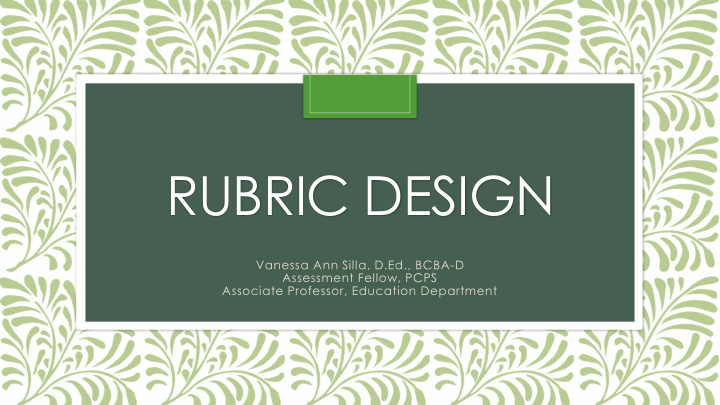



RUBRIC DESIGN Vanessa Ann Silla, D.Ed., BCBA-D Assessment Fellow, PCPS Associate Professor, Education Department
Objectives • In this presentation, the learner will: • Define rubric • Identify the difference between rote Learning and multidimensional learning • Identify the necessary components in a rubric • Evaluation Criteria • Proficiency Levels • Review a sample rubric • Outline the six steps in making an instructional rubric
Think Pair Share #1 • Familiarity, view and experiences • How familiar are you with rubrics? • What is your current view of rubrics? • Have you ever written original rubrics? • Describe your experience and what you learned from writing the rubrics.
Definition of a Rubric • A rubric is an assessment device that uses clearly specified evaluation criteria and proficiency levels that measure student achievement of those criteria. • Products, process, or progress may be evaluated by using rubrics. • “A rubric is a coherent set of criteria for students' work that includes descriptions of levels of performance quality on the criteria .”(Association for Supervision and Curriculum Development, 2017)
Multidimensional Learning vs. Rote Learning • Rote Learning • The memorization of information that is based on repetition • Examples include multiplication, spelling words, the elements and their chemical numbers • Since rubrics assess multidimensional tasks, there is no reason to use rubrics for rote learning. • In fact, it would amount to a one-criterion rubric. • Multidimensional Learning • Performance-based, authentic learning often has three elements (content knowledge, acquisition of skills, development of work habits) • “In the act of learning, people obtain content knowledge, acquire skills, and develop work habits— and practice the application of all three to “real world” situations. Performance -based learning and assessment represent a set of strategies for the acquisition and application of knowledge, skills, and work habits through the performance of tasks that are meaningful and engaging to students.” (ASCD, 2017) • Rubrics are appropriate for assessing multidimensional learning, as they
Advantages of Rubrics • Help students learn • Rubrics help clarify for students the qualities their work should have. • Students understand the learning target and criteria for success • The criteria and performance level descriptions in rubrics help students understand what the desired performance is and what it looks like. • Help teachers teach • Allow performance assessment to be more objective • Focus on what teachers intend students to learn rather than what teachers intend to teach • Rubrics help keep teachers focused on criteria and not tasks • It becomes very easy for teachers to focus on task completion rather than criteria and learning • Help coordinate instruction and assessment • Provide useful feedback on both student achievement and the effectiveness of instruction • Most rubrics should be designed for repeated use, over time, on several tasks.
Defining Characteristics of Rubrics • The two defining characteristics of rubrics are the following: • coherent sets of evaluation criteria • What “counts” in a project or assignment • descriptions of proficiency levels (levels of performance) for these criteria • Gradations of quality
Defining Characteristic #1: Evaluation Criteria • What “counts” in a project or assignment • Evaluation criteria should • match the task that the student is asked to do • be known in advance by the student • be distinct from one another • be specific and reflective of exactly what it takes to succeed on the task • be specific and understandable to students
Defining Characteristic #2: Proficiency Levels • Levels of performance for the criteria • Proficiency levels should be • Descriptive • Clear • Cover the whole range of performance • Distinguish among levels • Center the target performance (acceptable, mastery, passing) at the appropriate level • Feature parallel descriptions from level to level
Think Pair Share #2 • Application of a Rubric for a Learning Goal or Outcome • Describe a particular learning goal or outcome in the content area you teach for which using a rubric for giving feedback would be particularly appropriate. • What rubric would you use? • How would you use it to give students feedback ? • How would students use the feedback ? • What would you expect to be the result ?
How to Make an Instructional Rubric 1. Look at models 2. List evaluation criteria 3. Pack and unpack criteria 4. Articulate proficiency levels (levels of quality) 5. Create a draft rubric 6. Revise the draft Avoid designing rubrics that are long, cumbersome to use and have little to no inter-rater reliability.
Think Pair Share #3 • Evidence of Enhanced Learning and Improved Learning Skills • What evidence would it take to convince you that using rubrics with learning- based criteria in your classroom would enhance learning of content outcomes and improve students' learning skills as well? • How can you get that evidence in your own classroom?
Summary • Rubrics help teachers teach as well as evaluate student work. • Rubrics are most appropriate for evaluating multidimensional learning rather than rote learning tasks. • The two necessary components of a rubric are evaluation criteria and proficiency levels. • Evaluation criteria provide specific descriptions of each level of performance in terms of what students are able to do • Proficiency levels of performance are present and make sense • Making an instructional rubric involves looking at models, listing the criteria, packing and unpacking the criteria, articulating proficiency levels, creating a draft rubric, and revising the draft.
Recommend
More recommend